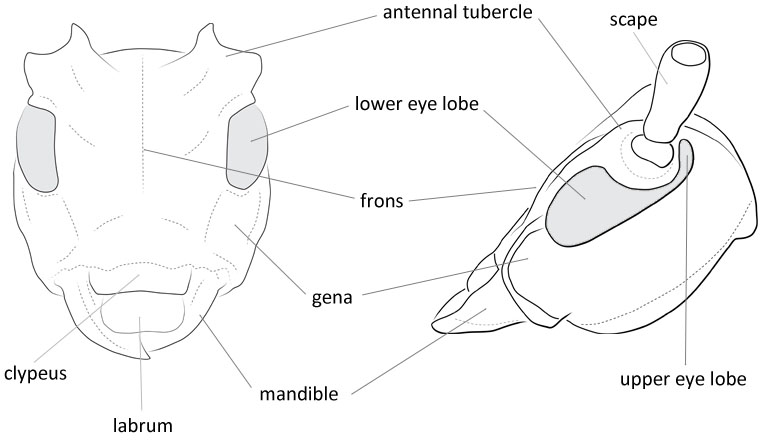Body length: 7.6–15 mm.
Eyes: eye interommatidial setaeseta:
a sclerotized hair-like projection of the cuticle
absent, eye deeply emarginateemarginate:
notched at the margin > half width, eye ommatidial density fine.
> half width, eye ommatidial density fine.
Antennaeantenna:
in larval and adult insects, paired segmented appendages, borne one on each side of the head, functioning as sense organs and bearing a large number of sensilla
: antennal length reaches between basebase:
the part of any appendage or structure that is nearest the body
and end of elytraelytron:
the leathery forewing of beetles, serving as a covering for the hind wings, commonly meeting opposite elytron in a straight line down the middle of the dorsum in repose
or reaching/surpassing end of body, antennal flagellar segments elongateelongate:
much longer than wide
, scapescape:
the first proximal segment of the antenna smooth/punctate at apexapex:
smooth/punctate at apexapex:
end of any structure distad to the base
, antennal segment 3 > scapescape:
the first proximal segment of the antenna .
.
Pronotumpronotum:
the upper and dorsal part of the prothorax
: pronotumpronotum:
the upper and dorsal part of the prothorax
shape transversetransverse:
broader than long
, pronotumpronotum:
the upper and dorsal part of the prothorax
lateral armature absent.
Prosternum: prosternal processprosternal process:
a posterior extension of the prosternum between the coxae not dilated at apexapex:
not dilated at apexapex:
end of any structure distad to the base
, procoxal cavities open posteriorly.
Elytraelytron:
the leathery forewing of beetles, serving as a covering for the hind wings, commonly meeting opposite elytron in a straight line down the middle of the dorsum in repose
: elytral length reaching or close to end of abdomen, elytral apicesapex:
end of any structure distad to the base
rounded or truncatetruncate:
cut off squarely at the tip
, elytral color black, brown, reddish, or orange, elytral color pattern present or absent.
Legs: visible tarsomerestarsomere:
subdivision or article of the tarsus, usually numbering from two to five : 4, femora clavateclavate:
: 4, femora clavateclavate:
thickening gradually toward the tip
, rarely slender, protibial spursprotibial spur:
sclerotized spine(s) located at the distal tibia; can be single, double, or absent : 2, tarsal clawstarsal claw:
: 2, tarsal clawstarsal claw:
usually paired claws of the pretarsus, at the distal end of the leg simple.
simple.
Intercoxal process of prosternum narrow. Intercoxal process of prosternum long, reaching to, or nearly to, posterior borders of anterior coxae. Third antennal segment longer than fourth. Posterior femora not strongly clavateclavate:
thickening gradually toward the tip
. First two hind tarsal segments almost without pubescence beneath, each with a deep shiny groove along middle of lower surface; pronotumpronotum:
the upper and dorsal part of the prothorax
densely punctured (Gressitt 1951Gressitt 1951:
Gressitt JL. 1951. Longicorn beetles of China. Longicornia, Paris 2: 1–667, 22 pls.).
Ropalopus has posterior femora strongly clavateclavate:
thickening gradually toward the tip
. Pronocera has tarsomerestarsomere:
subdivision or article of the tarsus, usually numbering from two to five 1–3 hairy and no bald groove under tarsomerestarsomere:
1–3 hairy and no bald groove under tarsomerestarsomere:
subdivision or article of the tarsus, usually numbering from two to five .
.
Palearctic: central Asia
broadleaf; Abies, Picea
6 spp. in Turanium (Turanium). 2 spp. in (Chalcoturanium). T. (C.) juglandis and T. (T.) pilosum known from conifers and broadleaf. Genetic data produced in recent delimitation research (Karpinski et al. 2021Karpinski et al. 2021:
Karpiński L, Szczepański WT, Plewa R, Kruszelnicki L, Koszela K, and Hilszczanski J. 2021. The first molecular insight into the genus Turanium Baeckmann, 1922 (Coleoptera: Cerambycidae: Callidiini) with a description of a new species from Middle Asia. Arthropod Systematics & Phylogeny 79: 465–484.) is available on Genbank.
Turanium Baeckmann, 1922